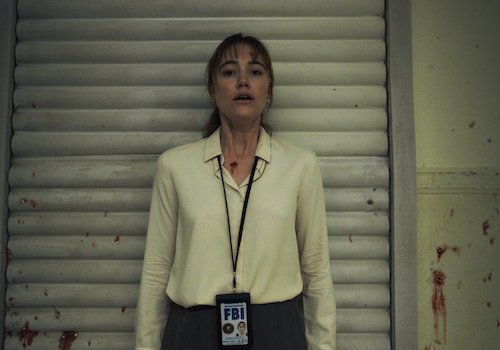Longlegs
Written by Andreas Babiolakis
In the day and age of the social media algorithm, it can be challenging to get your film’s name out there to the masses. Many production houses and distributors have struggled to get noticed in a reality where billions of online voices are colliding with one another and the slanted algorithm of various platforms — all finicky — skews favour for some over others. There’s a very good chance that something that actually pertains to you never makes its way to your device as a result. Then there’s what Neon accomplished with the oft discussed indie horror film Longlegs: a promotional campaign that rivals The Blair Witch Project and Cloverfield before it. With leaked footage that was originally untitled at the start of 2024, each material afterward felt like a breadcrumb that led you closer to trying to crack what Longlegs even is. As an unprecedented result, online users began making their own offshoots of ficticious Longlegs teasers in the same vein as meme culture: a burgeoning hysteria surrounding a film that hadn’t even existed yet (and it was becoming difficult to know what was attached to the film and what was make belief). Needless to say, Longlegs became anticipated.
The film was finally released last Friday, and we’ve got some concrete answers. The film stars Maika Monroe as a new FBI recruit, Lee Harker (think Clarice Starling in The Silence of the Lambs), who is questioned by her superiors when she is presented the daunting task of tracking down a paranormal serial killer who is only known by the monikor used to sign off coded messages: “Longlegs” (played by Nicolas Cage). Lee is a psychic which is seen as a possible advantage to finally cracking this decades-long chase. Meanwhile, Longlegs is difficult to crack. He is somehow able to get fathers of various families to kill their respective loved ones before ending their own lives. Each crime scene is adorned with a cipher (just like, say, the real life Zodiac Killer, albeit with different coding). No wonder why Lee’s team doubts her ability to figure this out so soon into her career; it’s not Lee’s greenness, but rather the insanity of what she is up against.
This vision comes from Osgood Perkins, who is none other than the son of Anthony Perkins (iconic for starring in Alfred Hitchcock’s Psycho) and model-actor Berry Berenson (who starred in a few horror and thriller films, including Paul Schrader’s take on Cat People, before we tragically lost her in the attacks on 9/11). It’s clear that horror and thriller films are a huge part of his DNA. From the jump, Longlegs feels different: like images being radioed into your cranium that you cannot fight off, as jump cuts and static shots do anything but ease you into this ninety minute affair (there’s no sense of comfort here). As quickly as you sense Perkins’ authorial voice, you will notice his heavy reliance on the works of yesteryear (you can see them as homages like I do, but I wouldn’t judge you for feeling like these are stolen ideas); outside of what I’ve previously brought up, the title cards scream Stanley Kubrick’s The Shining, murders taking place within six days of an event like The Ring (oh, my mistake, that’s seven days), the use of gold and blue colour palettes feels like David Fincher’s answer to the aforementioned killer in Zodiac, et cetera, et cetera. In fact, on the note of the latter named filmmaker, Longlegs screams Fincher throughout, from the muggy yet flourescent cinematography (including wide, long shots, including a driving sequence that felt like it came straight out of his adaptation of The Girl With the Dragon Tattoo), to the specific way the plot goes about picking up and revealing its clues and twists (quite similarly to Seven).
Longlegs is different enough to warrant all of the promotional buzz it garnered, but it still relies too heavily on the tropes and ideas of the past to stand tall on its own. Nonetheless, Longlegs is mostly effective: just not as much as it could have been.
Back to the plot. Lee notices a commonality between all of the cases: each slain family had a nine year old daughter born on the fourteenth (the month doesn’t matter in this case), with the murders taking place six days before or after the birthday (in case I haven’t brought up that Longlegs, the killer, is driven by the symbols and ideas of the Devil, let Longlegs, the film, remind you a trillion times). As Lee tries to solve the puzzle as to who is going to be the next — and potentially last — family to implode, she discovers that this case is actually perfect for her in more ways than one. This is when Longlegs becomes a bit of a peculiar take on religion: one where the damnation of the original sin will envelop you if you lose your faith. I don’t mind a horror film getting religious, but it can be handled really well or quite heavy-handedly (and Longlegs falls into the latter category). The start of the film feels like something with far more promise than a lesson on faith. A big portion of this theme comes from Lee’s highly devoted mother (Alicia Witt), who represents the punishment of straying away from God’s path no matter what part of the film you’re at.
It’s not all bad news regarding Longlegs, but I would argue that the start and end of the film are its strongest acts, mainly due to the coldness and unforgiving nature of Perkins’ direction. The midsection crawls a little bit and feels the most artificial tonally, but these moments are saved by a typically unhinged Cage who looks like a modern day Marilyn Manson in his unrecognizable prosthetics, and sounds like a wailing banshee from hell; his maximalism contrasts beautifully with the rest of the film’s stillness and ghostliness. All in all, Longlegs succeeds the most at what feels like Perkins’ goal from square one: placing you within the minds of both a serial killer, his next victims, and the agents trying to stop him. Even though the plot doesn’t get the memo (we barely ever wonder who Longlegs is because of the layout of the film, and most twists feel quite blatant because of the foreshadowing), the aesthetics and tone of Longlegs is wonderfully eerie. I wouldn’t call any part of the film scary, but I did feel compelled throughout Longlegs to find out what comes next (even if the plot would occasionally let me down or condescend to its audience).
As we are contained within our own minds for Longlegs (and the film matches the energy of our paranoia), situations like build ups, aftermaths, and the hidden details in between stand out a little bit more. I think Longlegs falls a bit flat on paper as a story but it is the cinematic experience — the immersion of the uncanny during our times of vulnerability and uncertainty — that elevates what could have been a bland, mediocre, forgettable film to an effective one that sadly happens to be flawed. It becomes abundantly clear that the film is a tug-of-war between Perkins and himself: Perkins the director, and Perkins the screenwriter. His eye as a filmmaker feels interesting (even if it is indebted to the works of others), while his voice as a storyteller holds himself back enough to be noticed (he’s almost like a reverse Aaron Sorkin, who is a magnificent writer but as plain as filmmakers get). I usually use this opportunity to express curiosity as to how a director and screenwriter will grow from this point on with upcoming projects, but I also cannot help but wonder what Longlegs fine tuned could have been.
We have hints of something gloriously shocking and exhilerating here, and we occasionally get these moments, but all of this build up and this potential is held down by a story that needed to quadruple check if it succeeded in including some of the numbers of the exhausted how-to books of old. Perkins clearly has what it takes to let loose completely, and he has the opportunity to do so still. With a film as promising as Longlegs (and especially given the many cards he’s given, and the plays that do work), I wish he chose to go all the way with this project.
Andreas Babiolakis has a Masters degree in Film and Photography Preservation and Collections Management from Toronto Metropolitan University, as well as a Bachelors degree in Cinema Studies from York University. His favourite times of year are the Criterion Collection flash sales and the annual Toronto International Film Festival.






